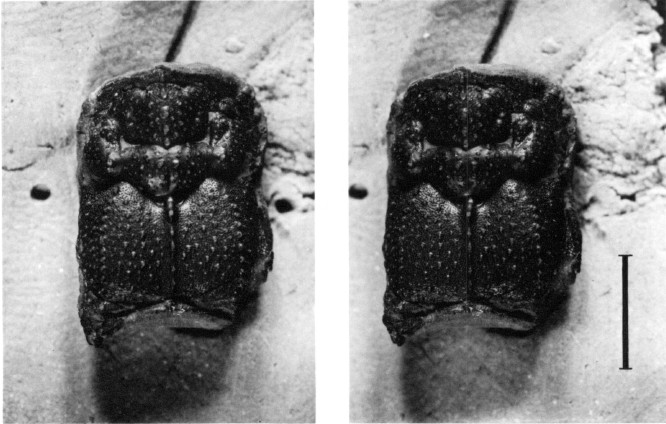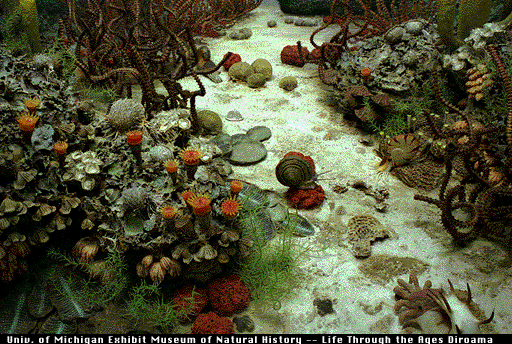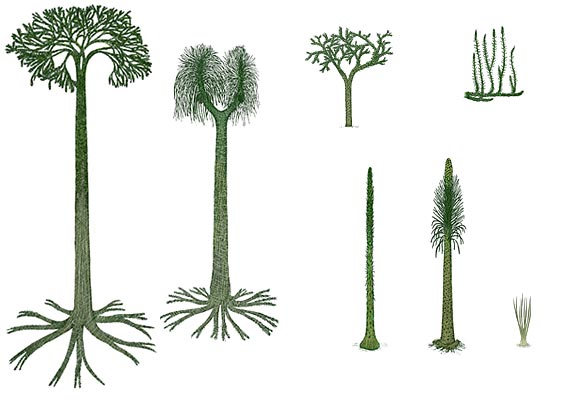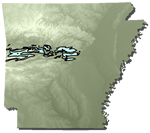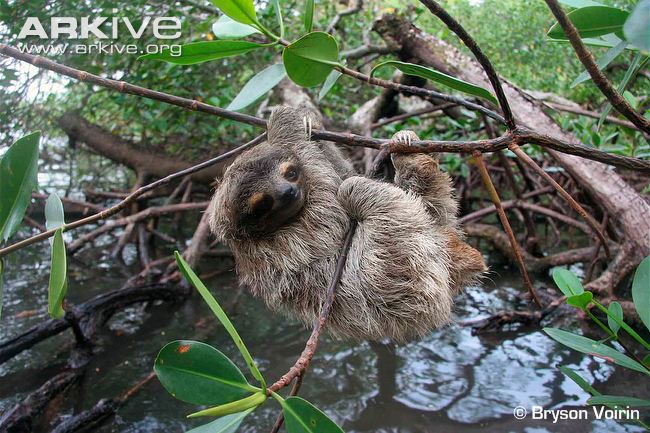Home » Paleontology » Fossils of Arkansas (Page 5)
Category Archives: Fossils of Arkansas
Fossil Friday, it’s a crabby day
Were you able to figure it out? Congratulations to Showmerockhounds for getting it right.
This picture shows the carapace of a decapod crustacean, the group that includes crabs, crayfish, lobsters, and shrimp. More specifically, it is Imocaris tuberuculata, a crab generally considered to be in the group Dromiacea, within Brachyura. The name means crab from the Imo Formation, which is where it was found by Frederick Schram and Royal Mapes in a roadcut along I-65 near Leslie, AR. The rocks around Leslie are a great place to hunt for invertebrate fossils, numerous specimens have come from there. Imocaris is very rare, but quite distinctive, with a carapace that looks like a frog-headed bodybuilder wearing enormous sequined parachute pants.

Fuxianahuia. 520-million-year-old crustacean with a heart. https://www.sciencenews.org/article/ancient-crustacean-had-elaborate-heart
Imocaris is an intriguing fossil in that the Imo Formation is thought to be Carboniferous in age, in the Upper Mississippian Period roughly 320-330 million years old. Even though the fossil record of decapods goes back to the Devonian Period, few exist in the Paleozoic, not really hitting their stride until the Mesozoic Era. The fossil record of crustaceans as a whole go all the way back to the Middle Cambrian over 500 million years ago, with specimens found in the Burgess Shale. Thus, the true origin of the crustaceans must be even earlier than that, probably some time in the early Cambrian or the Ediacaran, the latest stage of the preCambrian Era.

The contact (black line) between the Pitkin Limestone (above) and the Fayetteville Shale (below) along highway 65 near Marshall. Arkansas Geological Survey.
The Arkansas Geological Survey calls the Imo Formation as a member of the Pitkin Limestone Formation. The Imo is a shale layer interspersed with thin sandstone and limestone layers found nearthe top of the Pitkin Formation. The Imo, and the Ptikin in general, demonstrate a shallow marine environment indicated by the limestone and an abundance of marine fossils. Most of the fossils are invertebrates showing off a thriving coral reef system, but you can also find conodonts and shark teeth as well. The Pitkin Limestone sits on top of the Fayetteville Shale, itself well known for fossils, particularly cephalopods. The boundary between the two can be seen along I-65 closer to Marshall.
Mystery Monday
If the cold and the ice (or lack of ice for those of you hoping for a day off from school) has gotten you in a bad mood, see if you can distract yourself with solving this week’s mystery fossil. This week I am presenting something totally unlike anything I have presented before. The scale bar in the photo is 5 mm.
Last Week’s Mystery Monday Revealed: Getting to the Root of the Problem
 Were you able to figure out last Monday’s mystery fossil? For a reminder, here it is again.
Were you able to figure out last Monday’s mystery fossil? For a reminder, here it is again.
Two people correctly identified it as a plant fossil. While both guesses were fossils that are found in Arkansas in similar places and times, the Natural Historian identified this as a Stigmaria. Technically, Stigmaria is a “form taxon”, meaning that it is named for the shape and not the actual organism, but in general, the only ones that really get called Stigmaria are root casts of lycopsid trees. The two main ones are Sigilaria and Lepidodendron. This particular one is Lepidodendron, which is the typical one found in Arkansas.
Lycopsids like Lepidodendron lived during the Carboniferous Period from about 300 to 360 million years ago, so named because this was the time of extensive coal swamps. Coal swamps, as the name suggests, were responsible for most of the coal we find. During this time, organisms capable of digesting lignin, a chief component of wood, had not yet evolved and spread sufficiently to make a dent in the decaying logs. Lignin is a tough fiber, so without organisms capable of breaking it down, it tended to last for a long time, so decaying plant matter built up, eventually being compressed into coal. Genetic studies indicate that the enzyme to digest lignin first appeared around 300 million years ago, which likely not coincidentally marks the beginning of the end for coal swamps, which by and large died out in the Permian Period, not long after the end of the Carboniferous.
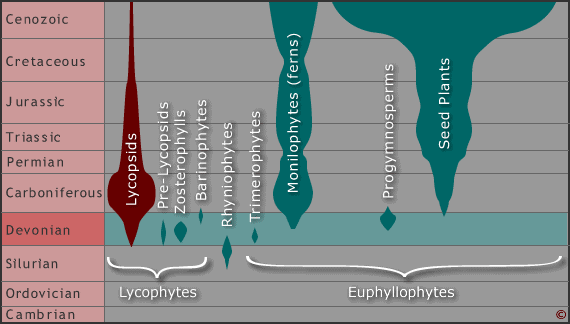
Image by Dennis Murphy. http://www.devoniantimes.org/who/pages/lycopsid.html
Lycopsids today include the quillworts, spike mosses, and club mosses, although Lepidodendron is most closely related to the quillworts. Today, these plants are small and serve mostly as ground cover. In the Carboniferous, they formed towering trees reaching over 40 m tall (just for comparison, the average oak tree is no more than 20 m, although they can get up to 30 m tall). They also grew very quickly, reaching maturity in only a few years, which likely also contributed to the massive buildup of decaying plant matter. Lepidodendron literally means “scale tree”, so called for their scaly appearance. They have occasionally been mistaken for fossils of snake or lizard skin. Personally, they remind me of giant pineapples.
Lepidodendron can be found in most of the Pennsylvanian age rocks in Arkansas, although the most common place is in the upper Atoka Formation in the Boston Mountains and the Arkansas River Valley through the northern section of the Quachitas. The Atoka Formation is a series that represents deep marine sediments at the base of the formation gradually turning into deltaic deposits in the upper sections. There are several layers of coal, coally shale, and oil shale. I have even seen a few spots in which the amount of oil in the shale is enough to smell it and the rock can catch fire. This region has not been extensively used by the coal and oil industries because it is prohibitively expensive to extract the oil from the shale and the coal is high in sulfur, making it less than optimal for use. But if you are looking for plant fossils in Arkansas, it is the place to go.
Mystery Monday
Halloween is over, time to get back to work for a few weeks before we take off for Thanksgiving. To get your brain back into gear after eating all that candy and waking up from sleeping like a log in your sugar coma, can you figure out what this week’s fossil is?
 Check back in next Monday for the answer. I will be at a conference on Thursday and Friday and will likely not be able to post an answer until after the conference is over. Or you can check the Facebook page for a quicker answer.
Check back in next Monday for the answer. I will be at a conference on Thursday and Friday and will likely not be able to post an answer until after the conference is over. Or you can check the Facebook page for a quicker answer.
Mysteries Revealed at a Slothful Pace
What happened to revealing the answer on Friday, you ask? If you follow the Paleoaerie Facebook feed, the answer was given there. Sadly, unexpected illness (as if one can schedule being sick) delayed me from getting a more complete post on the blog. Thus Fossil Friday has preempted Mystery Monday.
With that being said, were you able to figure out what this was?
If you thought they looked like teeth, you are quite right. But the chisel-like teeth are rather peculiar. To give some sense of scale, the teeth are roughly 10 cm long and 3 cm wide. So they are not small. They are hypsodont, meaning high-crowned, like that seen in the molars of horses, which is a good indication of herbivory. The cusps are simple, with only two cusps, unlike that seen in horses and other mammalian herbivores and totally unlike anything seen outside of Mammalia. The teeth are distinctive for particular group of animals, those known as sloths.
No, not that type. These teeth belonged to a giant ground sloth. Unlike their modern cousins, giant ground sloths are so named because they lived on the ground rather than in the trees and were very large, capable of standing upwards of 6 m (20 feet) high and weighing, depending on who you ask, 6-8 tons. Ones of this size are known as Megatherium and are commonly found in the La Brea Tar Pits, although they ranged throughout the Americas. The ones found in Arkansas are of the genus Megalonyx (“Great Claw”) were somewhat smaller than Megatherium, only about half the size of its larger kin, and ranged throughout North America.
Megalonyx jeffersonii, or Jefferson’s Ground Sloth, was so named because Thomas Jefferson gave a lecture on this animal in 1797 which is sometimes said to have marked the start of vertebrate paleontology in the United States.

Great American Interchange. Richard Cown http://mygeologypage.ucdavis.edu/cowen/
Giant ground sloths, as a group, originated in South America about 35 million years ago and made their way into North America during the Great American Interchange about 8-9 million years ago (this is often not considered to start until about 3 million years ago, but fossil evidence indicates at least some organisms began the march between the continents much earlier). The Great American Interchange was so named because this marked the time that North and South America became joined, creating a wide corridor through which many plants and animals passed. Interestingly, ground sloths were unusual in that they migrated northward. Most animals migrated south from North America. This was most likely due to the fact that Central America at the time was mostly scrubland, whereas the northern part of South America was covered in lush forests. This meant that those on the southern continent had little incentive to leave. The North American animals, on the other hand, were in areas of limited resources and would have viewed the abundant resources in the south as highly enticing.

Xenarthran joint. Dr. Kaci Thomspon. http://www.life.umd.edu/classroom/bsci338m/Lectures/Xenarthra.html
Another animal that went north during this time was one well known to many people in the southern Midwest, the armadillo. Interestingly, both sloths and armadillos are in the group called Xenarthrans, so-called for an extra articulation in the vertebra. Xenarthrans include sloths, armadillos, anteaters, and an interesting animal called a glyptodont, the mammalian equivalent to the ankylosaur. It had a bony carapace, a tail club, and was the size of a subcompact car. For some reason, the xenarthrans were far more successful moving north than almost any other animal, with the main exception of the giant, flightless terror birds in the group Phorusrachidae, such as Titanis, a bird towering 2.5 m (8 feet) or more tall.
Giant ground sloths lived in a variety of environments, ranging from arid savannas to jungles. Most of them, like Megalonyx, appear to have preferred lush forests along rivers and lakes.
I will end this with a statement of the end of the giant ground sloths. What drove them to extinction? They went extinct 10-12,000 years ago, at the end of the last ice age. This was also shortly after the arrival of humans, who, evidence suggests, hunted them on a regular basis. As large, slow-moving herbivores, they made for easy prey. Unlike other predators, humans could easily avoid the sharp claws and powerful forelimbs of the sloths by attacking with spears. Was it climate change or human overhunting, known as the overkill hypothesis? Many researchers fall on the side of human overkill due to the fact that the sloths had survived several similar periods of climate change without issue and the pattern of extinctions globally does not match well with local climate changes. However, others claim climate change due to the loss of plant diversity after the last ice age, which was not seen in the previous climatic shifts. Which is correct? Perhaps the answer is both. It is not unreasonable to think that the climate change lowered population levels, which ordinarily would have been survivable, but the added pressure of human hunting proved an insurmountable challenge.
National Fossil Day Celebration at the Museum of Discovery is Tomorrow!
Tomorrow is the day to see tons of fossils at the Museum of Discovery. Come out and see what Arkansas has to offer in fossils. We have a far more diverse array of fossils than most people realize. Here are a few dinosaurs you will see.
Here are some casts of Allosaurus bones, a foot and a humerus. Allosaurus itself didn’t live here, but its descendant, Acrocanthosaurus, did.
Here is an ischium of an Apatosaur, which did not live here either. But its titanosaur relatives did.
Here are some hands and claws of Allosaurus and Utahraptor, a giant version of Velociraptor.
Not interested in dinosaurs? How about a Smilodon, one of the biggest and most iconic of mammalian predators?
Of course, what I have shown the past few days is only a few things that the University of Arkansas Earth Sciences Department is bringing. The Anthropology Department will also be there with their own fossils. The Arkansas Geological Survey will be there with a cast of the dinosaur, “Arkansaurus” and more. The Virtual Fossil Museum will be present with more than virtual fossils. Not to be outdone, the Museum of Discovery will have a collection of dinosaur skulls on display, which will be part of an upcoming dinosaur exhibit which you won’t want to miss.
2 More Days to National Fossil Day at the Museum of Discovery
The National Fossil Day event at the Museum of Discovery is almost here.Here are a few more things you might see at the event. Here is a cast of a coelacanth, a lobe-finned fish that is closely related to the fish that started the trek onto land, and a mesosaur, an early reptile before reptiles and mammals went their separate ways.
Here is a Keichousaurus, another early reptile, and Greererpeton, an early amphibian that existed before reptiles evolved.

Want something with a bite to it? How about some teeth? Like Megalodon teeth, and a nodosaurid dinosaur, and how about the tooth of a giant ground sloth? What about primitive horse and rhino teeth?
Lots more to see. Come out and have a look. Bring your fossils and compare.
National Fossil Day in 3 Days
Here are some brachiopods you will see at the National Fossil Day event. They look much like clams, but are unrelated.
Here are some bryozoans, which look like they should be related to coral, but are thought to be more related to brachiopods because they share the same odd feeding structure.
Speaking of corals…
National Fossil Day in 4 Days
One of the common fossils you can find in Arkansas are cephalopods, which are all the squids, octopuses, and in terms of fossils, ammonoids. Arkansas has some very large ones. If one goes to Northeast Arkansas and looks in the Fayetteville Shale, one can find ammonoids with shells several feet long. Here is a preview of some of the fossils you will see Saturday.
 Of course, we can’t forget the other groups of molluscs, the bivalves (clams) and gastropods (snails).
Of course, we can’t forget the other groups of molluscs, the bivalves (clams) and gastropods (snails).

Yes, there are shark teeth and echinoderms in the drawer with the molluscs. These specimens were being used as examples of different types of fossilization.
Come back tomorrow for more fossil previews. Come to the museum to see much, much more.

